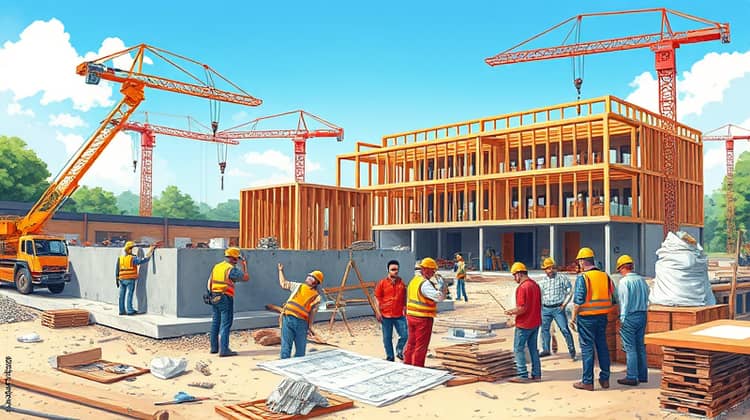Construction Loan Tips: Your Guide to Building Finance

Construction is a significant investment that requires a sound financial plan. Whether you're building your dream home or constructing a commercial property, obtaining the right type of financing is crucial for the project's success. One of the most common ways to fund construction projects is through construction loans, which offer specialized finance to meet the unique needs of building projects.
In this guide, we will explore construction loans in detail, including the different types available, how they work, and the application process. By understanding these aspects, you can make informed decisions that align with your financial goals and help ensure the successful completion of your construction project.
Additionally, we will provide essential tips for managing construction loans effectively, highlighting both potential risks and strategies for overcoming challenges. This comprehensive overview will equip you with the knowledge you need to navigate the construction financing landscape confidently.
Understanding Construction Loans

Construction loans are short-term loans designed specifically for financing construction projects. Unlike traditional mortgages, which are based on the final value of a completed property, construction loans are provided to cover the costs incurred during the building process. This can include everything from land purchases to labor and materials.
These loans are typically disbursed in stages, or 'draws', as construction progresses. Borrowers only pay interest on the amount drawn, rather than the total loan amount, making it a flexible option for managing cash flow during construction.
Given the unique nature of construction financing, lenders often require detailed project plans, timelines, and budgets. This careful assessment helps ensure that both the borrower and lender understand the potential risks involved and the strategies for mitigating them.
Types of Construction Loans

There are several types of construction loans available to cater to different needs and situations. The primary categories include construction-to-permanent loans, stand-alone construction loans, and renovation loans. Understanding which type of loan best fits your project can save time and money and streamline the overall process.
Construction-to-permanent loans combine the construction financing and long-term mortgage into a single loan, eliminating the need for two separate applications and reducing overall costs. Stand-alone construction loans, on the other hand, provide financing exclusively for the construction phase, requiring borrowers to apply for a mortgage separately once the project is complete.
- Construction-to-permanent loans
- Stand-alone construction loans
- Renovation loans
Each type of loan has its own set of benefits and drawbacks, so it's essential to evaluate them carefully. By discussing your specific plans with a knowledgeable lender, you can pinpoint the right financing option for your construction needs.
How Construction Loans Work

Construction loans generally work by providing funding in increments based on project milestones. This means that as each phase of construction is completed, the lender will release the next portion of funds to cover the costs. Borrowers typically need to provide detailed plans and timelines to estimate when these draws will be needed.
It's important to understand that construction loans usually carry higher interest rates than traditional mortgages, reflecting the increased risk to the lender. Additionally, they may require a higher down payment, often around 20% of the total project cost.
Borrowers should also be prepared for potential contingencies and delays, as construction projects rarely go exactly to plan. Maintaining open communication with the lender and having a solid budget in place can help to manage these challenges effectively.
Construction Loan Tips

When it comes to securing a construction loan, preparation is key. Start by thoroughly researching your specific needs and project estimates. Knowing your budget and having a clear project timeline will not only bolster your application but also improve your chances of approval. Additionally, the more organized your documentation, the easier it will be for lenders to assess your qualifications and project viability.
Consider working with a financial advisor or a mortgage broker who specializes in construction loans. Their expertise can guide you through the selection process and ensure you are making the best financial decisions for your project.
- Gather all necessary documentation: project plans, budgets, timelines.
- Shop around for lenders: compare interest rates and terms.
- Prepare for potential contingencies: expect delays and budget accordingly.
- Maintain open communication with your lender throughout the process.
- Review and understand the terms before signing any agreements.
By following these tips, you can maximize your chances of obtaining the best possible construction financing and set yourself up for success during your building project.
The Application Process

Applying for a construction loan can be more complex than traditional mortgage applications, requiring specific documentation and planning. Start by assembling your project plans, which should include detailed drawings and cost estimates, as well as a timeline of the construction process. Lenders will want to see that you have a clear understanding of the project scope and any potential risks involved.
Next, complete the loan application with detailed personal and financial information. This information allows lenders to determine your creditworthiness and assess any potential risks associated with your project.
- Project plans and specifications
- Budget estimates detailed
- Timeline of construction phases
- Personal financial information
Being thorough in your application will help facilitate a smoother approval process and reduce delays, which is especially important in construction projects that are time-sensitive.
Managing Your Loan

Once your construction loan is secured, effective management is crucial to ensuring the project stays on track both financially and logistically. Regularly track your budget and expenses, and maintain communication with your builder to avoid overspending or unexpected costs.
Additionally, establish a clear plan for fund draws based on your construction schedule. This organization helps prevent disruptions in the funding flow and keeps the project moving forward as planned.
Finally, keep documentation of all transactions and communication with your lender on hand. This approach ensures complete transparency and accountability throughout the loan period, which benefits both parties involved.
Risks and Challenges

Construction loans come with their fair share of risks and challenges, primarily due to the nature of construction itself. Delays caused by weather, supply chain issues, or labor shortages can impact the project's timeline and budget, leading to financial strain on the borrower.
Moreover, project costs can fluctuate unexpectedly. If a project goes over budget, it may require additional funding or adjustments to the scope of work. In some cases, lenders may need to reassess the project, which can result in complications or increased costs for the borrower.
To mitigate these risks, it's important to work closely with a reputable builder and maintain a contingency fund for unexpected expenses. This proactive approach can help manage the inherent uncertainties of construction projects.
Conclusion

Investing in a construction loan can be a powerful tool for achieving your building goals, whether it’s constructing a new home or a commercial property. By understanding the various types of loans available, how they work, and the best practices for managing them, you can navigate the financing landscape with confidence.
Ultimately, thorough preparation, informed decision-making, and effective management will set the stage for a successful construction project that aligns with your financial and personal objectives.






